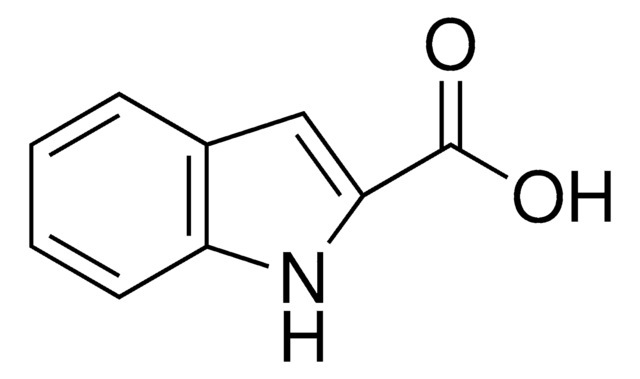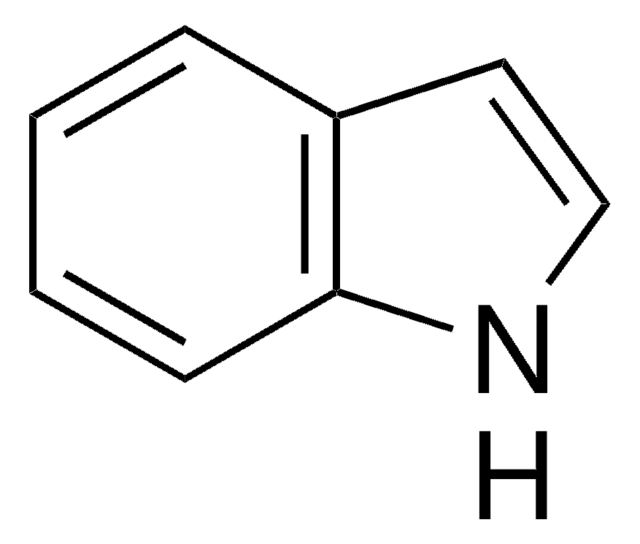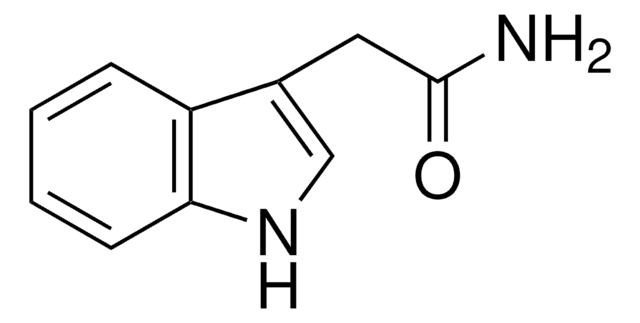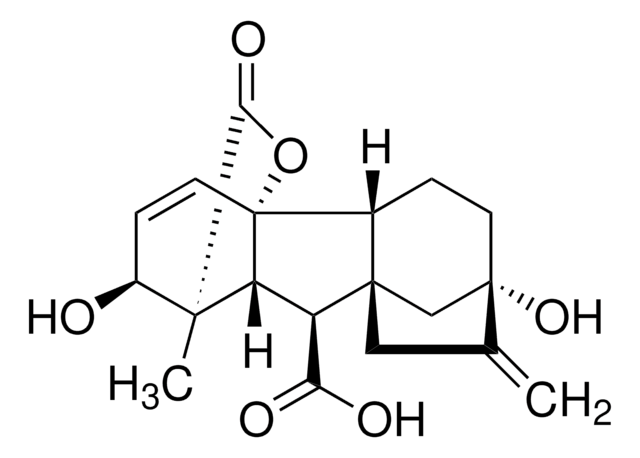CDS021628
Indole-2-acetic acid
Anmeldenzur Ansicht organisationsspezifischer und vertraglich vereinbarter Preise
Alle Fotos(1)
About This Item
Empirische Formel (Hill-System):
C10H9NO2
Molekulargewicht:
175.18
MDL-Nummer:
UNSPSC-Code:
12352106
PubChem Substanz-ID:
Empfohlene Produkte
Beschreibung
AldrichCPR
Form
solid
SMILES String
OC(CC1=CC(C=CC=C2)=C2N1)=O
InChI
1S/C10H9NO2/c12-10(13)6-8-5-7-3-1-2-4-9(7)11-8/h1-5,11H,6H2,(H,12,13)
InChIKey
QOPBEBWGSGFROG-UHFFFAOYSA-N
Sonstige Hinweise
Please note that Sigma-Aldrich provides this product to early discovery researchers as part of a collection of unique chemicals. Sigma-Aldrich does not collect analytical data for this product. Buyer assumes responsibility to confirm product identity and/or purity. All sales are final.
NOTWITHSTANDING ANY CONTRARY PROVISION CONTAINED IN SIGMA-ALDRICH′S STANDARD TERMS AND CONDITIONS OF SALE OR AN AGREEMENT BETWEEN SIGMA-ALDRICH AND BUYER, SIGMA-ALDRICH SELLS THIS PRODUCT "AS-IS" AND MAKES NO REPRESENTATION OR WARRANTY WHATSOEVER WITH RESPECT TO THIS PRODUCT, INCLUDING ANY (A) WARRANTY OF MERCHANTABILITY, (B) WARRANTY OF FITNESS FOR A PARTICULAR PURPOSE, OR (C) WARRANTY AGAINST INFRINGEMENT OF INTELLECTUAL PROPERTY RIGHTS OF A THIRD PARTY, WHETHER ARISING BY LAW, COURSE OF DEALING, COURSE OF PERFORMANCE, USAGE OF TRADE OR OTHERWISE.
NOTWITHSTANDING ANY CONTRARY PROVISION CONTAINED IN SIGMA-ALDRICH′S STANDARD TERMS AND CONDITIONS OF SALE OR AN AGREEMENT BETWEEN SIGMA-ALDRICH AND BUYER, SIGMA-ALDRICH SELLS THIS PRODUCT "AS-IS" AND MAKES NO REPRESENTATION OR WARRANTY WHATSOEVER WITH RESPECT TO THIS PRODUCT, INCLUDING ANY (A) WARRANTY OF MERCHANTABILITY, (B) WARRANTY OF FITNESS FOR A PARTICULAR PURPOSE, OR (C) WARRANTY AGAINST INFRINGEMENT OF INTELLECTUAL PROPERTY RIGHTS OF A THIRD PARTY, WHETHER ARISING BY LAW, COURSE OF DEALING, COURSE OF PERFORMANCE, USAGE OF TRADE OR OTHERWISE.
Signalwort
Warning
H-Sätze
P-Sätze
Gefahreneinstufungen
Eye Irrit. 2 - Skin Irrit. 2 - STOT SE 3
Zielorgane
Respiratory system
Lagerklassenschlüssel
11 - Combustible Solids
WGK
WGK 3
Flammpunkt (°F)
Not applicable
Flammpunkt (°C)
Not applicable
Hier finden Sie alle aktuellen Versionen:
Analysenzertifikate (COA)
Lot/Batch Number
Leider sind derzeit keine COAs für dieses Produkt online verfügbar.
Wenn Sie Hilfe benötigen, wenden Sie sich bitte an Kundensupport
Besitzen Sie dieses Produkt bereits?
In der Dokumentenbibliothek finden Sie die Dokumentation zu den Produkten, die Sie kürzlich erworben haben.
Kunden haben sich ebenfalls angesehen
Daiana R Duca et al.
Antonie van Leeuwenhoek, 111(9), 1645-1660 (2018-03-02)
The plant growth-promoting rhizobacterium Pseudomonas sp. UW4 was transformed to increase the biosynthesis of the auxin, indole-3-acetic acid (IAA). Four native IAA biosynthesis genes from strain UW4 were individually cloned into an expression vector and introduced back into the wild-type
Adriano Stephan Nascente et al.
Environmental science and pollution research international, 24(32), 25233-25242 (2017-09-21)
Microorganisms can promote plant growth by increasing phytomass production, nutrient uptake, photosynthesis rates, and grain yield, which can result in higher profits for farmers. However, there is limited information available about the physiological characteristics of lowland rice after treatment with
Oriana Flores et al.
Frontiers in microbiology, 9, 1907-1907 (2018-09-07)
In recent years, Chilean kiwifruit production has been affected by the phytopathogen Pseudomonas syringae pv. actinidiae (Psa), which has caused losses to the industry. In this study, we report the genotypic and phenotypic characterization of 18 Psa isolates obtained from
Cristian Dal Cortivo et al.
Frontiers in plant science, 8, 2072-2072 (2017-12-23)
Most crops are routinely protected against seed-born and soil-borne fungal pathogens through seed-applied fungicides. The recently released succinate dehydrogenase inhibitor (SDHI), sedaxane
Timothy A Tomko et al.
ACS synthetic biology, 6(7), 1343-1350 (2017-03-21)
Microorganisms can produce hydrocarbons that can serve as replacements or additions to conventional liquid fuels for use in the transportation sector. However, a common problem in the microbial synthesis of biofuels is that these compounds often have toxic effects on
Unser Team von Wissenschaftlern verfügt über Erfahrung in allen Forschungsbereichen einschließlich Life Science, Materialwissenschaften, chemischer Synthese, Chromatographie, Analytik und vielen mehr..
Setzen Sie sich mit dem technischen Dienst in Verbindung.








